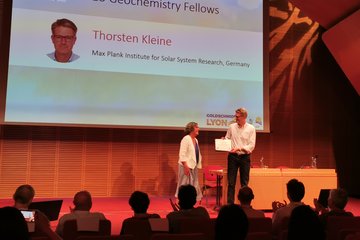Alle Typen
1.
Zeitschriftenartikel
Spectral variability of photospheric radiation due to faculae - II. Facular contrasts for cool main-sequence stars. Monthly Notices of the Royal Astronomical Society 524, S. 1139 - 1155 (2023)
2.
Zeitschriftenartikel
The influence of convective blueshift on radial velocities of F, G, and K stars. Astronomy and Astrophysics 610, A52 (2018)
3.
Zeitschriftenartikel
Estimates of Active Region Area Coverage through Simultaneous Measurements of the He I λλ 5876 and 10830 Lines. Astrophysical Journal 839 (2), 97 (2017)
4.
Zeitschriftenartikel
Spectral variability of photospheric radiation due to faculae I. The Sun and Sun-like stars. Astronomy and Astrophysics 605, A45 (2017)
5.
Zeitschriftenartikel
MESA meets MURaM. Surface effects in main-sequence solar-like oscillators computed using three-dimensional radiation hydrodynamics simulations. Astronomy and Astrophysics 592, A159 (2016)
6.
Zeitschriftenartikel
The Rossiter-McLaughlin effect reloaded: Probing the 3D spin-orbit geometry, differential stellar rotation, and the spatially-resolved stellar spectrum of star-planet systems. Astronomy and Astrophysics 588, A127 (2016)
7.
Zeitschriftenartikel
Radial velocity observations of the 2015 Mar. 20 eclipse A benchmark Rossiter-McLaughlin curve with zero free parameters. Astronomy and Astrophysics 595, A26 (2016)
8.
Zeitschriftenartikel
Three-dimensional simulations of near-surface convection in main-sequence stars - III. The structure of small-scale magnetic flux concentrations. Astronomy and Astrophysics 581, A42 (2015)
9.
Zeitschriftenartikel
Three-dimensional simulations of near-surface convection in main-sequence stars - IV. Effect of small-scale magnetic flux concentrations on centre-to-limb variation and spectral lines. Astronomy and Astrophysics 581, A43 (2015)
10.
Zeitschriftenartikel
Three-dimensional simulations of near-surface convection in main-sequence stars II. Properties of granulation and spectral lines. Astronomy and Astrophysics 558, A49 (2013)
11.
Zeitschriftenartikel
Three-dimensional simulations of near-surface convection in main-sequence stars I. Overall structure. Astronomy and Astrophysics 558, A48 (2013)
12.
Zeitschriftenartikel
Simulations of the solar near-surface layers with the CO5BOLD, MURaM, and Stagger codes. Astronomy and Astrophysics 539, A121 (2012)
13.
Zeitschriftenartikel
Properties of simulated sunspot umbral dots. Astronomy and Astrophysics 510, A12 (2010)
14.
Zeitschriftenartikel
Transverse Component of the Magnetic Field in the Solar Photosphere Observed by SUNRISE. Astrophysical Journal 723 (2), S. L149 - L153 (2010)
15.
Konferenzbeitrag
Modelling the Spectral Contrasts of Stellar Faculae. In: The 19th Cambridge Workshop on Cool Stars, Stellar Systems, and the Sun (CS19), Uppsala, Sweden, 06-10 June 2016, Bd. CS19, 63 (Hg. Feiden, G. A.). (2016)
16.
Vortrag
MHD simulations of sunspots and starspots with MURaM. Nordita Workshop on Sunspot formation: theory, simulations and observations, Stockholm, Sweden (2015)
17.
Poster
MHD simulations of surface convection in cool main-sequence stars. Cool Stars 18, Flagstaff, USA (2014)
18.
Hochschulschrift - Doktorarbeit
Simulations of magnetoconvection in cool main-sequence stars. Dissertation, Georg-August-Univ., Göttingen (2014)











